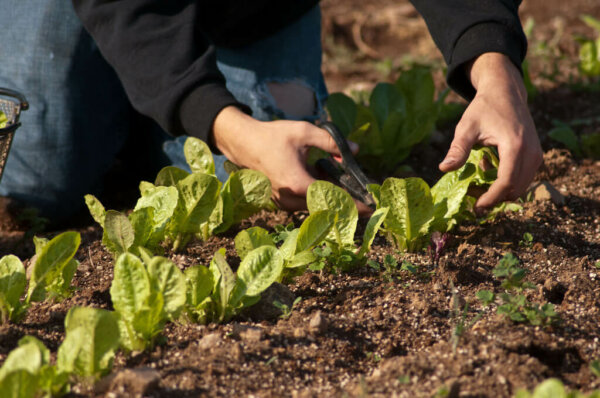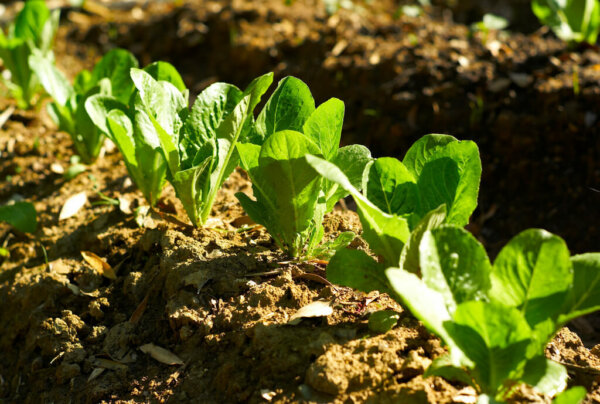There is nothing more foundational to eating fresh vegetables than lettuce. It comes in many varieties and in many dishes on your table. Though usually not spectacular to eat on its own, it is a cornerstone of many beloved salads and a topping for an infinite variety of wraps, sandwiches, tacos, and so on.
It’s one of my favorite things to grow in a garden because it doesn’t keep long in the fridge, I eat a lot of it, and it is easy and fast to grow! Here are some tips and tricks for getting started growing lettuce.
Starting Lettuce Seeds
One of my favorite parts of the growing season is going through seed catalogs in the winter and dreaming of my garden.
There are so many types of lettuce, from the cabbage-like iceberg to the leafy green romaine, that one might be forgiven for mistaking them for different plants altogether. The two main categories of lettuce are leaf lettuce and heading lettuce.

As the names suggest, the leaf varieties of lettuce never form a head—they have a growth pattern similar to spinach and are cut as salad greens. When the leaves are cut, they continue to produce. Heading varieties grow around a single, compact heart, and the whole head is cut at once during harvest.
Choosing Seeds For Their Flavor
The flavors of lettuce vary widely. There are sweet and tender lettuces like butterhead, named for its smooth texture and mild flavor. Bitter greens like endive and radicchio are actually part of the chicory family, though they have similar growth patterns and growing needs.
Try ordering a few different varieties of seed and doing a taste comparison after you have grown them. You’ll find much more variety in seeds than you are likely to ever find at the grocery store or even at the farmer’s market. Be sure to place your orders early in the season, because seed companies sometimes run out of popular varieties by mid-spring.
Since lettuce seeds are small and rod-shaped, they can be awkward to handle while seeding. Many people buy pelletized lettuce seed, which has been rolled in an inert substance which gives the seeds a uniform roundness and more manageable size. This allows for mechanical seeding, vacuum seeding in a greenhouse, and direct seeding with a wheeled planter. However, pelletized seeds are significantly more expensive.
To get a head start on the season, lettuce is typically started indoors about three weeks to a month before the last frost date. It’s very important to start lettuce in multiple successions.
As it grows, it quickly becomes bitter, and there is a relatively small window of harvest for each plant. If you want lettuce consistently throughout the season, plant at least every two weeks. In spring, start those seeds in your greenhouse, and you can direct seed later.
Planting Lettuce
Before planting, get to know your soil. Lettuce likes light, well-drained soils that are high in organic matter and have a pH between 6 and 7.
Lettuce is extremely vulnerable to hot weather. It will germinate as soon as the soil temperature comes above freezing but stops growing entirely above 75 degrees Fahrenheit. Starts can be transplanted outside as soon as the danger of frost is past, and new successions can be directly seeded at that time.
Depending on your climate, lettuce is usually a spring and fall crop. Even in temperate areas like the maritime Northwest, the height of August becomes too hot to grow lettuce outside. In more tropical areas, lettuce is a winter crop. During hot weather, a shade house—like a hoop house but for cooling rather than heating—can help lettuce power through hot afternoons. Companion planting with tall, bushy crops like cabbage or beneath fruit trees, achieves the same purpose. Although it grows best in full sun, in hot weather, lettuce can tolerate partial shade.
Follow the seeding directions on the seed packet for spacing and depth. Starts should be transplanted 2-3 inches apart for leaf varieties and 6-8 for heading varieties. Leaf lettuce, in particular, doesn’t take much space and can be grown on windowsills inside. Do keep in mind the greenhouse effect created by a sunny window, though. An area with indirect sun might be better.
Lettuce is mostly water, and with wide leaves, it loses hydration to evapotranspiration—the process of water evaporating out of cell walls into the air—very quickly. On a warm day, it may want to be watered more than once, so a sprinkler or drip system is helpful and takes less time out of your day. If you irrigate just once, do it in the evening to prevent moisture loss to evaporation.
Troubleshooting Pests And Diseases
Lettuce is a succulent and tender leaf that pests love just as much as humans. Keeping slugs, and even mice, from gnawing on your lettuce is work of constant vigilance. Some home remedies for slugs include traps made out of soda cans or beer bottles, barriers of copper wire, or salt. Home remedies for stopping slugs are marginally effective at best, and salting is bad for the soil, but a combination of techniques can reduce slug problems.
It’s also important to not over-water. Although lettuce likes lots of moisture, so do slugs and molds. Lettuce is susceptible to a number of mildews and fungi, all of which thrive in damp conditions. These diseases cause wilting and rotting either in the leaves or from the stem of the plant.
Some varieties of lettuce have been bred for greater disease resistance, so if you have persistent problems, consider changing what you are growing. The soil surface should be dry to the touch, and moisture should be about a half inch down before watering. Good airflow is also important—be sure to plant lettuce far enough apart to prevent dampness and crowding between the plants.
Harvesting Lettuce
Lettuce becomes bitter fast, especially in hot weather. If you are growing baby lettuce, you can harvest several successions, usually up to three, before the new growth becomes bitter. Pinch the leaves or use a pair of scissors to cut about two inches above the base of the plant, higher than the central nub which is still growing.
If you cut the leading leaves the lettuce will stop producing. For heading lettuce, harvest before the center leaves begin to open, while the heart is still tight. Use a knife to slice the head of lettuce at the base. You only get one harvest off heading lettuce, which is why it is so vital to plant a number of successions.

Harvest in the early morning or late evening when temperatures are moderate, and dunk the leaves in cold water immediately after harvest, before packing them out of the field. That will help give the lettuce longevity before it begins to wilt. Wash the lettuce thoroughly in cold running water before storing. The lower leaves of lettuce get dirt caught between them and stuck to them, and dirt can carry many harmful pathogens.
If you have access to refrigeration, put the lettuce in an airtight container in the fridge or a walk-in cooler. Lettuce will keep for a week, sometimes two weeks, depending on the variety. Romaine is not particularly hardy. It bruises very easily and will start to spoil first from bruised areas and along the edges of the leaves, so handle it gently to improve longevity.

Whether you have a farm, a garden, or an apartment window, lettuce is a productive and easy staple to grow fresh from your kitchen. Be sure to give it enough sun and water, and watch it thrive. If you need more support, always remember to ask other gardeners, local experts, farmers at the market, specialists at your county extension, or members of your local master gardener program. As always, when we are farming or gardening, the most important thing we are cultivating is community.
The Art Of Seasonal Salads
I grew up in a house where my mother was always making enormous salads in our largest steel mixing bowl. Basically, anything can go in a salad, especially on top of lettuce. Apples, pears, citrus, pomegranate, bell peppers, broccoli, snap peas, raw onion, caramelized onion, all kinds of nuts, mushrooms, roasted sweet potato, pickled beets, shaved zucchini, not to mention eggs, beans, cheese, and meat. If it’s edible, it can be put in a salad.
So where to begin? The real joy of seasonal garden salads is to put whatever is growing into your salad, and fresh, tender lettuce is the basis for all of that. But the art of salads comes from pairing the dressing with the salad toppings. It is easy to fall back on a basic vinaigrette—not a bad starting place. But a few changes can dress up a salad enormously.
Here are three variations on a basic dressing—one part olive oil to one part balsamic vinegar:
Early Spring
Fresh lettuce topped with snap peas and raw asparagus—two crunchy, fresh textures and contrasting flavors. We want a refreshing dressing with a savory note to compliment the asparagus. To your basic dressing, add a dash of Worcester sauce and enough lemon juice to dilute the sweetness of the balsamic. Season with salt, pepper, and herbs de Provence.
Summer
Fresh lettuce with tomatoes and basil, sprinkled with feta and cauliflower crumbles.
This is a dish that can use a strong, simple flavor to complement the strong flavors of basil and feta without masking the fruitiness of the tomato. Cut the balsamic with red wine vinegar for a sharper, less sweet dressing, and blend with avocado for a distinctly tangy flavor with a creamy texture.
Fall
Fresh lettuce with walnuts, pears, and caramelized onions.
A sweet dish wanting a delicate sauce. Add nutmeg and a few crushed blackberries (fresh or frozen); salt to taste.
Lettuce is a mild flavor that allows the toppings and dressings to create the dish. Bitter lettuce disrupts that harmony. Be sure to harvest promptly!









































Leave a Reply